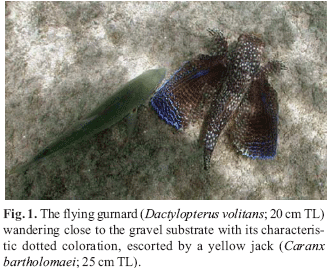Following behaviour among reef fishes involves mostly a digging nuclear species while foraging, which attracts opportunistic followers preying on the exposed organisms. The flying gurnard Dactylopterus volitans preys on benthic animals, mostly crustaceans and small fishes, scratching and probing the bottom with the inner rays of its pectoral fins. We recorded the flying gurnard being followed by two opportunistic predators, the yellow jack Caranx bartholomaei and the coney Cephalopholis fulva at Fernando de Noronha, off northeast Brazil. Albeit not actually digging the substrate, the flying gurnard acts as a nuclear species by exploring algae tufts and by its wandering near the boulders and ledges, disturbing and flushing out hidden animals which thus become available to predation.
Nuclear forager; following behaviour; foraging association; reef fishes; Equatorial West Atlantic

